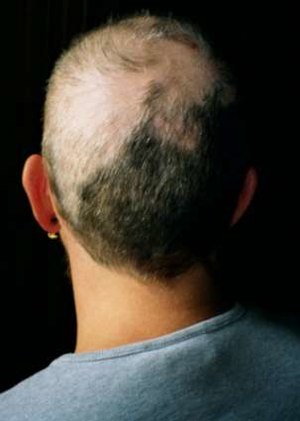拔毛癖
拔毛癖是一种强迫行为,患者会有反复拔除头发、睫毛、胡须、鼻毛、耻毛、眉毛或其他体毛的冲动,有时会造成明显的光秃区块。[2][4]过程中会试图停止拔毛,不过努力多半会失败。[1]拔毛癖在《精神疾病诊断与统计手册》第四版中分类为冲动控制疾患,但仍然有人对本疾病的分类存疑。拔毛癖有时看起来像是一种习惯、瘾、抽动症或强迫症。拔毛癖通常是从青少年时期开始的。沮丧或压力都有可能引发拔毛癖。[2]受到社会大众的观念影响,患者往往会隐匿自己的病情,因而很难确切估计拔毛癖的盛行率;美国有250万人可能患有拔毛癖,盛行率约1%。[5]
| 拔毛癖 Trichotillomania | |
|---|---|
| 又称 | Trichotillosis、hair pulling disorder[1] |
 | |
| 有拔毛癖的人,其头上部分秃发的情形 | |
| 读音 | |
| 症状 | 脱发、忧虑[1][2] |
| 起病年龄 | 儿童或是青少年[2] |
| 风险因素 | 家族病史、焦虑、强迫症[1] |
| 诊断方法 | 根据症状[1] |
| 鉴别诊断 | 身体畸形恐惧症[1] |
| 药物 | 认知行为疗法、氯米帕明[3] |
| 患病率 | ~2%[2][3] |
| 分类和外部资源 | |
| 医学专科 | 皮肤病学、精神病学 |
| ICD-11 | 6B25.0 |
| ICD-10 | F63.3 |
| ICD-9-CM | 312.39 |
| OMIM | 613229 |
| DiseasesDB | 29681 |
| MedlinePlus | 001517 |
| eMedicine | 1071854、915057 |
拔毛癖通常会采用认知行为疗法。[6]研究显示,以相反习惯训练辅助药物治疗的方法是成功的。[7]在相反习惯训练中,医师会训练患者学习认知自己拔除毛发的冲动,也会教导他们转移这种冲动。相反习惯训练也包括行为记录,医师通常会指示患者制作拔毛事件的日志,内容包括日期、时间、地点、拔下的毛发数量,还有当时在想什么、感觉如何。这样可以帮助患者学会发现自己通常会拔除毛发的情况,并发展出避免拔毛事件发生的对策。
药物治疗方面,一项小型的双盲实验研究显示,氯米帕明——一种三环抗抑郁剂(现在已少用)——能显著改善症状。[8]氟西汀(百忧解)和其他类似的SSRI型药物治疗拔毛癖的效果有限,而且经常会造成显著的副作用。[9]根据弗莱德·潘索(Fred Penzel)的说法,抗抑郁剂甚至可能加重拔毛癖的病情。[10]拔毛癖患者中,也有仅借由行为治疗、家族治疗及支持性会谈治疗等非药物疗法即痊愈的病例。[11]拔毛癖的患者遍及各年龄层;20岁以前较常见,症状开始发生的年龄平均在9到13岁之间。学龄前儿童中,男女患者各占一半;青春期前至青少年时期,女性患者较多,所占比例在70%到93%之间。[12]现在有证据指出易患拔毛癖的倾向与基因有关。[13][14]近年来报告的拔毛癖案例增加,或许是因为社会赋予拔毛症状的污名已经减少。全球人口中,拔毛癖患者比例的估计值已经从1-3%[15]上升到5%。[14]女性比男性更容易被影响。[4]
命名由François Henri Hallopeau于1889年所创建,取语源于希腊语θρίξ/τριχ; thrix(原意为“头发”),以及τίλλειν; tíllein(原意为“拉动”)和μανία; 狂热(原意为“疯狂”)。[4]
特征
编辑拔毛癖患者的生活相当正常;然而,他们头上的睫毛、头发或眉毛等区域可能会有光秃的区块。在心理上,拔毛癖也有可能造成低自尊, 通常是因为患者的外貌和旁人负面的关注,造成同侪的躲避和患者本身对社交的恐惧。有的患者会戴帽子、戴假发、画眉毛或者为头发做造型,以避免负面的关注。压力似乎是拔毛癖的一项重要成因。有些患者在压力低的环境里不会表现出任何症状(也就是拔毛行为)。离开压力低的环境之后,症状又会复发。[16]
很多精神科医师将拔毛癖归类为习惯行为,与咬甲癖(onychophagia)或强迫性皮肤搔抓症同类。这些疾病兼具精神疾病与和身体疾病的特征:精神疾病方面,它们像是强迫症,因为看见或感觉到某个身体部位会引起焦虑;身体疾病方面,则像制式行为疾患,因为患者会不停做出重复的动作,而不会感到困扰,或者他们对这些动作并不完全自觉。有人怀疑目前将拔毛癖与纵火狂、问题赌博、窃盗癖同样归类于冲动控制疾患的分类方式并不恰当,需要修订。[10]有一项研究显示拔毛癖患者的小脑体积较小。[17]拔毛癖患者也比一般人更容易有焦虑、沮丧、强迫症的问题。[18]拔毛癖患者可能会咀嚼或吃掉自己拔下来的头发,称为食毛癖。在极端情况下,这种行为会导致毛石肠梗阻症候群,名称取自格林童话中的长发姑娘,因停滞在消化道中的毛球会从胃部延伸至小肠甚至大肠而得名),甚而致死。[19][20][21]因为表明病情的患者比例很低,有些患者会觉得自己是唯一有这种问题的人。[22]
遗传学
编辑此疾患可能在家庭内遗传。[4]它更常是会发生在有着强迫症患者的家庭里。拔毛的病征可能是因为焦虑所引发的。[4]人们通常会承认有拔自己的毛发。在检查时,可以找到断裂的发丝。其他可能出现类似条件的疾患包含身体畸形恐惧症,然而在此疾患的人们除去毛发的原因是因为其想要让自己的外表更好看。[4]
在一项研究中,被怀疑会引起拔毛癖的基因注射到实验用小鼠体内后,小鼠就开始做出拔除自己和笼内其他小鼠毛发的强迫行为。[23]这显示拔毛癖可能是基因造成的,并且会代代相传。
参见
编辑参考资料
编辑- ^ 1.0 1.1 1.2 1.3 1.4 1.5 American Psychiatric Association, Diagnostic and Statistical Manual of Mental Disorders (5th ed.), Arlington: American Psychiatric Publishing: 217–221, 938, 2013, ISBN 0890425558
- ^ 2.0 2.1 2.2 2.3 2.4 Franklin, Martin E.; Zagrabbe, Kathryn; Benavides, Kristin L. Trichotillomania and its treatment: a review and recommendations. Expert Review of Neurotherapeutics. 2011-8, 11 (8): 1165–1174 [2018-10-18]. ISSN 1744-8360. PMID 21797657. doi:10.1586/ern.11.93. (原始内容存档于2018-10-18).
- ^ 3.0 3.1 Huynh M, Gavino AC, Magid M. Trichotillomania. Semin Cutan Med Surg. June 2013, 32 (2): 88–94. PMID 24049966.
- ^ 4.0 4.1 4.2 4.3 4.4 4.5 1972-, Pittenger, Christopher,. Obsessive-compulsive disorder : phenomenology, pathophysiology, and treatment. OCD. New York, NY. ISBN 9780190228163. OCLC 1011443715.
- ^ Diefenbach, G.J., Reitman, D. & Williamson, D.A.,. Trichotillomania: A challenge to research and practice. Clinical Psychology Review. 2000, 20 (20): 289–309. doi:10.1016/S0272-7358(98)00083-X.
- ^ Huynh, Monica; Gavino, Aide Carlo; Magid, Michelle. Trichotillomania. Seminars in Cutaneous Medicine and Surgery. 2013-6, 32 (2): 88–94 [2018-10-18]. ISSN 1085-5629. PMID 24049966. (原始内容存档于2019-05-21).
- ^ Woods DW, Wetterneck CT, Flessner CA. A controlled evaluation of acceptance and commitment therapy plus habit reversal for trichotillomania. Behaviour research and therapy. 2006, 44 (5): 639–56. PMID 16039603. doi:10.1016/j.brat.2005.05.006.
- ^ Swedo SE, Leonard HL, Rapoport JL, Lenane MC, Goldberger EL, Cheslow DL. A double-blind comparison of clomipramine and desipramine in the treatment of trichotillomania (hair pulling). N. Engl. J. Med. 1989, 321 (8): 497–501. PMID 2761586.
- ^ Christenson GA, Mackenzie TB, Mitchell JE, Callies AL. A placebo-controlled, double-blind crossover study of fluoxetine in trichotillomania. Am J Psychiatry. November 1991, 148 (11): 1566–71 [2009-01-08]. PMID 1928474. (原始内容存档于2012-09-28).
- ^ 10.0 10.1 Penzel. The Hair-Pulling Problem: A Complete Guide to Trichotillomania. Oxford University Press. 2003: 3. ISBN 0-19-514942-4.
- ^ 刘广齐,黎欣怡,姚成荣,陈盘铭. 成功治癒拔毛症之經驗——一例報告. 慈济医学. 2003年4月, 15 (2): 135–139 [2021-08-16]. (原始内容存档于2021-08-16).
- ^ Sah DE, Koo J, Price VH. Trichotillomania. Dermatol Ther. 2008, 21 (1): 13–21. PMID 18318881. doi:10.1111/j.1529-8019.2008.00165.x.
- ^ Entrez Gene: HOXB8 homeobox B8 (Homo sapiens). National Center for Biotechnology Information. 2006-08-12 [2009-01-08].
- ^ 14.0 14.1 Hair pulling disorder gene found. BBC News. 2006-09-29 [2009-01-08]. (原始内容存档于2009-05-27).
- ^ Christenson GA, Mackenzie TB, Mitchell JE. Characteristics of 60 adult chronic hair pullers. Am J Psychiatry. 1991, 148 (3): 365–70.
- ^ Christenson GA, Mackenzie TB, Mitchell JE. Characteristics of 60 adult chronic hair pullers. The American journal of psychiatry. 1991, 148 (3): 365–70. PMID 1992841.
- ^ Keuthen NJ, Makris N, Schlerf JE; et al. Evidence for reduced cerebellar volumes in trichotillomania. Biol. Psychiatry. 2007, 61 (3): 374–81. PMID 16945351. doi:10.1016/j.biopsych.2006.06.013.
- ^ Christenson GA, Crow SJ. The characterization and treatment of trichotillomania. The Journal of clinical psychiatry. 1996,. 57 Suppl 8: 42–7; discussion 48–9. PMID 8698680.
- ^ Ventura DE, Herbella FA, Schettini ST, Delmonte C. Rapunzel syndrome with a fatal outcome in a neglected child. J. Pediatr. Surg. 2005, 40 (10): 1665–7. PMID 16227005. doi:10.1016/j.jpedsurg.2005.06.038.
- ^ Pul N, Pul M. The Rapunzel syndrome (trichobezoar) causing gastric perforation in a child: a case report. Eur. J. Pediatr. 1996, 155 (1): 18–9. PMID 8750804.
- ^ Hairball in stomach kills teenager. hairgrowthnews.com. [2009-01-08]. (原始内容存档于2006-03-19).
- ^ Christenson GA, MacKenzie TB, Mitchell JE. Adult men and women with trichotillomania. A comparison of male and female characteristics. Psychosomatics. 1994, 35 (2): 142–9. PMID 8171173.
- ^ Gene Targeting, Homeobox Genes, Development, and Behavior (新闻稿). Howard Hughes Medical Institute. 2008-05-01 [2008-07-12]. (原始内容存档于2013-06-28).
延伸阅读
编辑- Keuthen, Stein, Christensen & Christenson (2001) Help for Hair Pullers: Understanding and Coping With Trichotillomania; New Harbinger Publications, ISBN 1-57224-232-9
- Parker (Ed.) (2004) Trichotillomania - A Medical Dictionary, Bibliography, and Annotated Research Guide to Internet References ; Icon Health Publications, ISBN 0-597-84664-2
- Stein (Ed.), Christenson (Ed.) & Hollander (Ed.) (1999) Trichotillomania; American Psychiatric Press, ISBN 0-88048-759-3